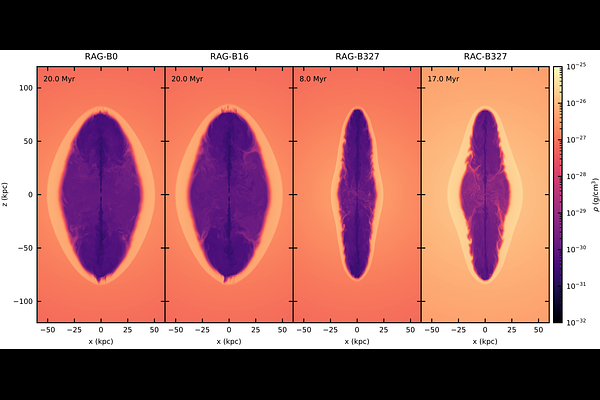BRAiSE: synthetic polarisation in RMHD AGN jet simulations

BRAiSE: synthetic polarisation in RMHD AGN jet simulations
Larissa Jerrim, Stas Shabala, Patrick Yates-Jones, Martin Krause, Ross Turner, Georgia Stewart, Chris Power
AbstractWe present a new method to calculate the polarised synchrotron emission of radio AGN sources using magnetic field information from 3-dimensional relativistic magnetohydrodynamical (RMHD) simulations. Like its predecessor, which uses pressure as a proxy for the magnetic field, this method tracks the spatially resolved adiabatic and radiative loss processes using the method adapted from the Radio AGN in Semi-analytic Environments formalism. Lagrangian tracer particles in RMHD simulations carried out using the PLUTO code are used to track the fluid quantities of each `ensemble of electrons' through time to calculate the radio emissivity ex-situ. By using the magnetic field directly from simulations, the full set of linear Stokes parameters I, Q, and U can be calculated to study the synthetic radio polarisation of radio AGN sources. We apply this method to a suite of RMHD simulations to study their polarisation properties. The turbulent magnetic field present in radio lobes influences the emission, causing a complex clumpy structure that is visible at high resolution. Our synthetic polarisation properties are consistent with observations; we find that the fractional polarisation is highest (approximately 50 percent) at the lobe edges. We show that for the same source, the integrated and mean fractional polarisation depends on viewing angle to the source. At oblique viewing angles the behaviour of the integrated and mean fractional polarisation over time depends on the morphology of the jet cocoon. Using Faraday rotation measures, we reproduce known depolarisation effects such as the Laing-Garrington depolarisation asymmetry in jets angled to the line of sight. We show that the hotspots and hence the Fanaroff-Riley classification become less clear with our new, more accurate method.